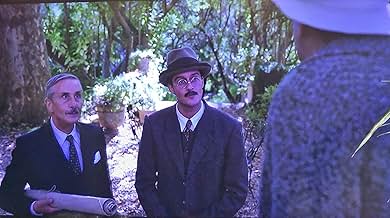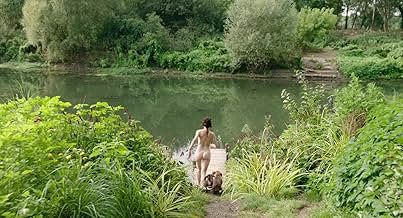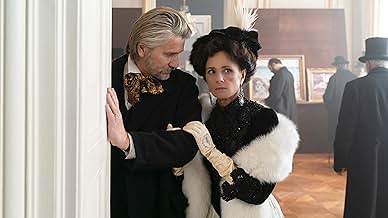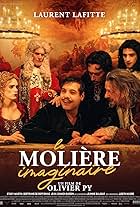IMDb RATING
6.5/10
719
YOUR RATING
The life of French painter Pierre Bonnard and his wife, Marthe de Méligny, over five decades.The life of French painter Pierre Bonnard and his wife, Marthe de Méligny, over five decades.The life of French painter Pierre Bonnard and his wife, Marthe de Méligny, over five decades.
- Director
- Writers
- Stars
- Director
- Writers
- All cast & crew
- Production, box office & more at IMDbPro
Featured reviews
For his second film about a painter, Martin Provost is far less inspired than he was with "Séraphine"
In recounting five decades in the life of the Nabi artist Pierre Bonnard, nicknamed the "painter of happiness", and his model companion, muse and finally wife, Marthe, he certainly produces some fine images and a good period reconstruction, and tells us a great deal about these two complementary beings. However, a few serious shortcomings tend to spoil the broth: the pace that becomes increasingly languid, the dialogue that sometimes seems like a copy-paste from Wikipedia, three very unconvincing dream sequences and downright painful scenes of hysteria. Fortunately, the pair of lead actors, totally invested in their characters, save the day: Vincent Macaigne (in first role as a real-life character) and Cécile de France (who knows how to convey every emotion).
Nothing to be ashamed of, but Martin Provost has already proved, with "Séraphine", that he can do better.
In recounting five decades in the life of the Nabi artist Pierre Bonnard, nicknamed the "painter of happiness", and his model companion, muse and finally wife, Marthe, he certainly produces some fine images and a good period reconstruction, and tells us a great deal about these two complementary beings. However, a few serious shortcomings tend to spoil the broth: the pace that becomes increasingly languid, the dialogue that sometimes seems like a copy-paste from Wikipedia, three very unconvincing dream sequences and downright painful scenes of hysteria. Fortunately, the pair of lead actors, totally invested in their characters, save the day: Vincent Macaigne (in first role as a real-life character) and Cécile de France (who knows how to convey every emotion).
Nothing to be ashamed of, but Martin Provost has already proved, with "Séraphine", that he can do better.
Moving moving moving
personally I rate Bonnard as one of the greats of the 20th C ; in my top five; most of them French (1900 -1925) or German expressionists from the same time frame
knew nowt about his life and Marthe; I do now if this is accurate a depiction of their lives
he is known for the complexity of his strokes and the fact that Picasso hated him always made me like him even more "he uses yellow green pink blue brown" he needs to make up his mind and use only one said the Malagueño brute; he could not see it .... his loss , too understated for him
Marthe in the bath (multiple versions) is one of the most subtle works of the 20thC
Anyway to the filum. Was very dubious when i saw they had cast. Vincent Macaigne as Pierre and Cécile de France as Marthe
I have seen them in so many films always comedies and brilliant both of them in those it seems Vincent Macaigne must have dieted severely to play the elfin Bonnard I have seen him to be usually portly; but I was very surprised they really shifted into those characters; I suppose that is what great actors do.
Totally recommended for lovers of Art before Duchamp destroyed Art 🙂🙃😉 single-handedly; also great scenes in French countryside here.
personally I rate Bonnard as one of the greats of the 20th C ; in my top five; most of them French (1900 -1925) or German expressionists from the same time frame
knew nowt about his life and Marthe; I do now if this is accurate a depiction of their lives
he is known for the complexity of his strokes and the fact that Picasso hated him always made me like him even more "he uses yellow green pink blue brown" he needs to make up his mind and use only one said the Malagueño brute; he could not see it .... his loss , too understated for him
Marthe in the bath (multiple versions) is one of the most subtle works of the 20thC
Anyway to the filum. Was very dubious when i saw they had cast. Vincent Macaigne as Pierre and Cécile de France as Marthe
I have seen them in so many films always comedies and brilliant both of them in those it seems Vincent Macaigne must have dieted severely to play the elfin Bonnard I have seen him to be usually portly; but I was very surprised they really shifted into those characters; I suppose that is what great actors do.
Totally recommended for lovers of Art before Duchamp destroyed Art 🙂🙃😉 single-handedly; also great scenes in French countryside here.
Bonnard, Pierre and Marthe - a treat of a film for any art lover, or those who aspire to a life of lounging around the French countryside eating, having sex and painting the odd masterpiece. Enjoy lunch with Claude (Monet), who has rowed down the river from his place with cooked pheasant and bottle of Bordeaux in hand... what's not to like? The production design, hair and makeup, and costumes are superb, and all the performances are top notch, though Cécile de France stands above the rest as Marthe. It may be ten minutes too long but that's not worth quibbling about. A truly enjoyable film that's absolutely delicious and well worth your time, go see it.
'Bonnard: Pierre & Marthe' (2023) is a film I would have had many reasons to like. It is the biopic of an artist from a revolutionary period of fine arts. It's a love story that takes place over half a century. It's a well-written and beautifully shot film, made by a film director who has already proven that he knows how to make excellent films about artists. And yet, something is missing. In 2008, Martin Provost directed and wrote 'Séraphine', a film about a very special artist with a spectacular biography. He then managed to enter her soul and bring to the screen a damned destiny of a female artist who suffered a lot in life. Unlike Séraphine Louis, Pierre Bonnard, considered the 'painter of happiness', had a relatively easy life, the support of his protectors launched his career and his commercial success ensured a life without material problems. Even the love story depicted in the film, with its ups, downs and dramas, is, at least seen from afar, a happy one, almost unique in the world of artists. Like it or not, traumatized lives and unhappy love stories are better filmed than long lives and long-surviving relationships.
The scene that opens the film takes place in 1893 in the Parisian studio of the young painter Pierre Bonnard. The artist had just met Marthe, noticing her on the street and inviting her to pose for him. What the French call a 'coup de foudre' takes place. In a few hours the two end up in bed and a few days later Pierre proposes to the young woman to spend their lives together. Marthe comes from a modest background, she is a worker in an artificial flower factory, she is intelligent and does not seem to lack education, but she is intimidated by the social environment and by Pierre's friends, a mixture of artists and rich people (including women) who support them. She knows that if she says yes and is lucky, she'll devote her life to supporting an artist with his eccentricities who is also a man with the specific manly egoism. If she says yes and is not lucky, the risk is that she will be very unhappy. She says Yes. The two move outside the city to a house on the banks of the Seine, a boat trip from the Givenchy of Claude Monet, who is Bonnard's friend and mentor, in a natural setting with the waters and lights that cradled Impressionism . The relationship is not without its ups and downs. Bonnard gives Marthe enough reasons to be jealous. At least two other women play an important role in his life: the pianist Misia Sert who became a patron of the arts and artists using the wealth of her successive husbands and the young artist Renée Monchaty, a late love that puts their relationship in danger. Only after this last affair fails, the two will marry, after more than 30 years of cohabitation. The First World War had marked the middle of their lives and their love story, the Second World War the end.
'Bonnard: Pierre & Marthe' lasts two hours. Martin Provost tells the story in detail, includes a lot of anecdotes gathered from the artists' memoirs or from the press of the time. It is not about the painter's biopic but about telling a love story. If there is no love, there is no art. The emphasis doesn't always seem to be on the most significant details. Some of the scenes that take place in the house on the banks of the Seine seem repetitive, while the dramatic episode of the relationship with Renée and her suicide in parallel with Martha's transformation into an artist seems superficially addressed. The most successful scenes seemed to me to be the ones where we see Bonnard (played by the excellent Vincent Macaigne) painting. In collaboration with the director of cinematography Guillaume Schiffman, film director Martin Provost manages here something that I also liked in 'Séraphine' - he harmonizes the color palette of the artist with the description of the environment that surrounded him, indicating the influence and creating an aesthetic vibration between the two visual universes. Psychologically, however, the characters cannot be deciphered until the end, despite all the efforts of Vincent Macaigne and Cécile de France in the role of the woman who dedicates her life to the artist.
I confess that I am not a big fan of Pierre Bonnard's paintings. I admire his technique, I respect his courage, I recognize his contribution to the history of art, but I cannot immerse myself in his art. My relationship with his paintings is one of aesthetic appreciation and not emotional vibration. I had about the same feeling when watching this movie.
The scene that opens the film takes place in 1893 in the Parisian studio of the young painter Pierre Bonnard. The artist had just met Marthe, noticing her on the street and inviting her to pose for him. What the French call a 'coup de foudre' takes place. In a few hours the two end up in bed and a few days later Pierre proposes to the young woman to spend their lives together. Marthe comes from a modest background, she is a worker in an artificial flower factory, she is intelligent and does not seem to lack education, but she is intimidated by the social environment and by Pierre's friends, a mixture of artists and rich people (including women) who support them. She knows that if she says yes and is lucky, she'll devote her life to supporting an artist with his eccentricities who is also a man with the specific manly egoism. If she says yes and is not lucky, the risk is that she will be very unhappy. She says Yes. The two move outside the city to a house on the banks of the Seine, a boat trip from the Givenchy of Claude Monet, who is Bonnard's friend and mentor, in a natural setting with the waters and lights that cradled Impressionism . The relationship is not without its ups and downs. Bonnard gives Marthe enough reasons to be jealous. At least two other women play an important role in his life: the pianist Misia Sert who became a patron of the arts and artists using the wealth of her successive husbands and the young artist Renée Monchaty, a late love that puts their relationship in danger. Only after this last affair fails, the two will marry, after more than 30 years of cohabitation. The First World War had marked the middle of their lives and their love story, the Second World War the end.
'Bonnard: Pierre & Marthe' lasts two hours. Martin Provost tells the story in detail, includes a lot of anecdotes gathered from the artists' memoirs or from the press of the time. It is not about the painter's biopic but about telling a love story. If there is no love, there is no art. The emphasis doesn't always seem to be on the most significant details. Some of the scenes that take place in the house on the banks of the Seine seem repetitive, while the dramatic episode of the relationship with Renée and her suicide in parallel with Martha's transformation into an artist seems superficially addressed. The most successful scenes seemed to me to be the ones where we see Bonnard (played by the excellent Vincent Macaigne) painting. In collaboration with the director of cinematography Guillaume Schiffman, film director Martin Provost manages here something that I also liked in 'Séraphine' - he harmonizes the color palette of the artist with the description of the environment that surrounded him, indicating the influence and creating an aesthetic vibration between the two visual universes. Psychologically, however, the characters cannot be deciphered until the end, despite all the efforts of Vincent Macaigne and Cécile de France in the role of the woman who dedicates her life to the artist.
I confess that I am not a big fan of Pierre Bonnard's paintings. I admire his technique, I respect his courage, I recognize his contribution to the history of art, but I cannot immerse myself in his art. My relationship with his paintings is one of aesthetic appreciation and not emotional vibration. I had about the same feeling when watching this movie.
Marthe de Méligny and the famous French painter Pierre Bonnard's complex relationship is explored in the biographical drama Bonnard, Pierre & Marthe. The story follows the creative and romantic relationship between the two over the course of fifty years, illuminating how Bonnard used Marthe as a model for many of his most lauded pieces. Set against the background of early 20th-century France, the story develops through pivotal points in their lives, capturing the spirit of their love.
Although the film strives for a more profound examination of love and art, it occasionally succumbs to the typical pitfalls of biopics, making the story feel less developed and more like a rundown of facts. While director Martin Provost deserves praise for skilfully tying together their lives' artistic and emotional threads, the pace, especially in the first act, can be tedious. The film's structure, with its four parts, gives us a look at their lives at different points, but it can feel disconnected at times.
The standout performances of the film are definitely Cécile de France's Marthe and Vincent Macaigne's Bonnard. Bonnard is portrayed by Macaigne as a kind soul torn between his creative aspirations and the intricacies of his relationship with Marthe; Macaigne gives him a relaxed, warm charm. However, the dynamic between Marthe and De France is riveting because De France personifies Marthe's ferocious and even aggressive personality. In scenes where Bonnard's work shows how Marthe's influence on him is apparent, demonstrating how his creativity is fuelled by their personal struggles, their chemistry is palpable.
Cinematographer Guillaume Schiffman does a masterful job capturing the intimate moments and verdant landscapes that make up Bonnard's universe. Its colour scheme is eye-catching and reminiscent of Bonnard's vivid paintings. Composer Michael Galasso's score adds a beautiful, wistful undercurrent to the images, heightening the narrative's emotional impact.
The film's pace is off, and it drags its feet when discussing its historical background, which detracts from the overall experience. The attempt to portray the social mores of that era is obvious, but there is frequently a chance to explore the characters' inner struggles that is not given enough attention. Even though there are touching moments, the dialogue isn't always natural and doesn't always raise the emotional stakes.
The personal, rather than merely the professional, aspects of Bonnard, Pierre & Marthe's subject matter set it apart from other artist biopics. Still, it falls short of the brilliance of films like Frida or Pollock, which do a better job of contrasting the artist's genius with the chaos of their life.
Bonnard, Pierre & Marthe is an emotionally moving portrait of a one-of-a-kind creative partnership and a gorgeously shot film overall. Art lovers and those interested in the complexities of love and creativity should watch it because, despite not fully escaping the conventions of its genre, it has strong performances and beautiful cinematography. Its artistic aspirations and narrative flaws are well-balanced. Watching this film is a must if you find yourself interested in how art and interpersonal relationships interact.
Although the film strives for a more profound examination of love and art, it occasionally succumbs to the typical pitfalls of biopics, making the story feel less developed and more like a rundown of facts. While director Martin Provost deserves praise for skilfully tying together their lives' artistic and emotional threads, the pace, especially in the first act, can be tedious. The film's structure, with its four parts, gives us a look at their lives at different points, but it can feel disconnected at times.
The standout performances of the film are definitely Cécile de France's Marthe and Vincent Macaigne's Bonnard. Bonnard is portrayed by Macaigne as a kind soul torn between his creative aspirations and the intricacies of his relationship with Marthe; Macaigne gives him a relaxed, warm charm. However, the dynamic between Marthe and De France is riveting because De France personifies Marthe's ferocious and even aggressive personality. In scenes where Bonnard's work shows how Marthe's influence on him is apparent, demonstrating how his creativity is fuelled by their personal struggles, their chemistry is palpable.
Cinematographer Guillaume Schiffman does a masterful job capturing the intimate moments and verdant landscapes that make up Bonnard's universe. Its colour scheme is eye-catching and reminiscent of Bonnard's vivid paintings. Composer Michael Galasso's score adds a beautiful, wistful undercurrent to the images, heightening the narrative's emotional impact.
The film's pace is off, and it drags its feet when discussing its historical background, which detracts from the overall experience. The attempt to portray the social mores of that era is obvious, but there is frequently a chance to explore the characters' inner struggles that is not given enough attention. Even though there are touching moments, the dialogue isn't always natural and doesn't always raise the emotional stakes.
The personal, rather than merely the professional, aspects of Bonnard, Pierre & Marthe's subject matter set it apart from other artist biopics. Still, it falls short of the brilliance of films like Frida or Pollock, which do a better job of contrasting the artist's genius with the chaos of their life.
Bonnard, Pierre & Marthe is an emotionally moving portrait of a one-of-a-kind creative partnership and a gorgeously shot film overall. Art lovers and those interested in the complexities of love and creativity should watch it because, despite not fully escaping the conventions of its genre, it has strong performances and beautiful cinematography. Its artistic aspirations and narrative flaws are well-balanced. Watching this film is a must if you find yourself interested in how art and interpersonal relationships interact.
Storyline
Did you know
- TriviaFrench visa # 155923 delivered on 25-9-2023..
- How long is Bonnard: Pierre & Marthe?Powered by Alexa
Details
- Release date
- Countries of origin
- Official site
- Language
- Also known as
- Bonnard - Konst och kärlek
- Filming locations
- Production companies
- See more company credits at IMDbPro
Box office
- Budget
- €7,950,000 (estimated)
- Gross worldwide
- $2,641,876
- Runtime2 hours 2 minutes
- Color
- Aspect ratio
- 1.85 : 1
Contribute to this page
Suggest an edit or add missing content






























